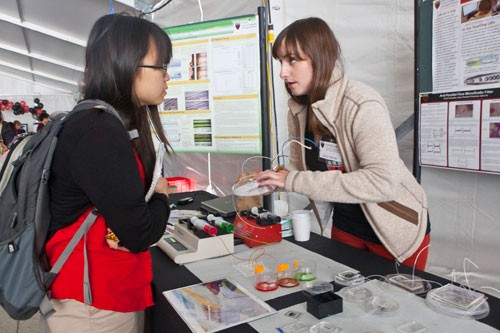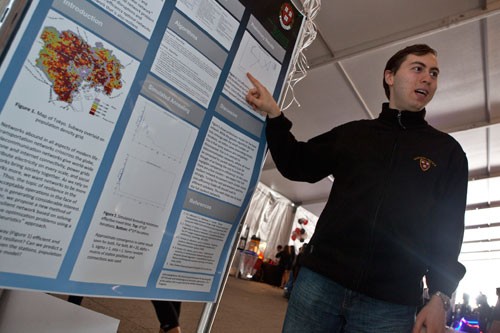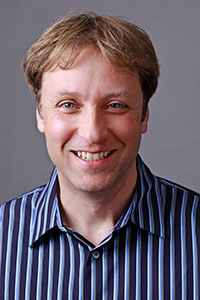News
"Do you remember the Nintendo Power Glove?" asked Tommy Chen '15. For his ES 50 final project, he recreated a kinetic video game controller from 1989, using an oven mitt. (Photo by Eliza Grinnell, SEAS Communications.)

Jamie Song '13 (right) strummed the invisible strings of a laser harp she designed with Doug Bright '13 (left) and their classmate Thomas Esch (not pictured). (Photo by Eliza Grinnell, SEAS Communications.)
The Design & Project Fair, an annual tradition at the Harvard School of Engineering and Applied Sciences (SEAS), drew almost two thousand people to the Science Center Plaza tent on May 3 for a carnival of creativity.
Hundreds of students presented projects with improbable-sounding names like iNose and InvisiHarp, while crimson frisbees sailed overhead. Budding engineers, computer scientists, applied mathematicians, and students from all across Harvard reveled in end-of-semester energy and the sheer diversity of the bold ideas on display.
Matthew Timoney '15 and Michael Martin '15 were drawing a crowd with their basketball hoop, modified with sensors to keep the score. Tommy Chen '15 waved around a green oven mitt outfitted with accelerometers to measure its roll and pitch, in homage to the Nintendo Power Glove of 1989. A programmable toaster singed custom designs into white sandwich bread, and a cocktail mixing machine took orders from a mobile app. Willy Xiao '16 had broken open a large water gun and filled its reservoirs with battery packs and a circuit board, transforming it into a laser tag gun with a modulated signal to identify multiple players. And all those were from a single course, ES 50, among a dozen courses taking part in the fair.
From medical devices to stochastic optimization methods, and from computer visualization to "design survivor," the classroom doors were flung wide open.
"I feel like a father figure all of a sudden," exclaimed Anas Chalah, Director of Instructional Laboratories, beaming with pride in a black SEAS t-shirt as throngs of students filled the tent that morning. "I get a bird's-eye view of their work during the semester, but toward the end you really see all of it come together."
Chalah, who oversees the equipment and activities of the SEAS teaching labs, arranged to have two 3D printers, a laser cutter, an "egg drop" tower, and some home-grown microfluidics technology brought out to the fair to demonstrate the sophisticated equipment available to Harvard students.

Sara Hamel (right), a staff engineer in the environmental and biological teaching labs at SEAS, explains a low-tech and affordable microfluidic device that has been developed in the teaching labs to demonstrate fluid dynamics. (Photo by Eliza Grinnell, SEAS Communications.)
The resulting projects from courses across SEAS were as intriguing as they were impressive: A mathematical system for crowdsourcing stock picks. An automatic fish feeder. A one-wheeled, self-balancing electric vehicle. A secret-knock-detecting door. A mind-controlled car. A Marauder's Map for the Harvard Innovation Lab—using not magic, as J. K. Rowling would have it, but Bayesian inference and Bluetooth.
"The projects are fantastic, and the students can show their peers so that more and more people will start thinking about taking courses in engineering and applied sciences," said Marko Lončar, Tiantsai Lin Professor of Electrical Engineering, who co-teaches ES 50 with Evelyn Hu, Gordon McKay Professor of Applied Physics and Electrical Engineering.
Teaching fellows for ES 50 supplied their students with t-shirts emblazoned with the words, "Trust me: I'm almost an electrical engineer." Lončar mused that the shirts were a little too popular among visitors to the fair, and within a couple of hours the box was empty. "I guess that's a good sign," he remarked.
As in many courses at SEAS, enrollment in ES 50 has skyrocketed, from 71 last spring to 164 this semester, likely driven by the course's emphasis on design and applications.
"I wanted to take a course that was a little out of the ordinary and a little more hands-on," said Austin Meyer '13, an environmental science concentrator who enrolled in ES 50 during his final semester at Harvard.
For his final project, Meyer "hacked" a remote-control power outlet to connect it to a home's wireless network. With a bit of programming, he and a classmate created a web application that allows them to turn the outlet on and off from anywhere in the world.
"I was studying a lot about electricity markets, and you see a lot of this type of thing in the electricity field right now, but I didn't know anything about the electronics behind it," Meyer said. "This has been really fun. It's expanded my mind."

Matthew Timoney '15 and Michael Martin '15 added sensors to a basketball hoop to make it keep score. (Photo by Eliza Grinnell, SEAS Communications.)
Ask the SEAS faculty what it means to design something, and you may receive many different answers, but they all agree that it goes far beyond art and intuition. It's a problem-solving process that must be taught—and practiced.
For Krzysztof Gajos, Assistant Professor of Computer Science, "It means answering the question: What is it that we should be designing in the first place? And then executing on the design and keeping your customer in the loop so that you design something that they want, need, and can use. That's a very hard thing to do well."
Gajos' course, CS 179, focuses on the design of interactive systems, where the user's needs and impressions are paramount, but the work is grounded in technical expertise.
Invoking the mantra of disruptive innovation made popular in management circles, Gajos said, "I want to empower engineers to be the innovators, to create products that are needed, attractive, useable, and useful."

For Applied Math 207, "Stochastic Optimization," Alexander Isakov (pictured) and David Bracher, second-year graduate students in physics, created a program that analyzes population density to find the best locations for subway stations in a city. (Photo by Eliza Grinnell, SEAS Communications.)
In CS 51, Greg Morrisett, Allen B. Cutting Professor of Computer Science, teaches another problem-solving tool: algorithms. "He really forces you to rethink what it means to code well," said Amna Hashmi '16.
With Kim Soffen '16, Hashmi created a machine learning neural network that can look at a photo of a page from a book and convert it, line by line and character by character, into editable text, with 94 percent accuracy. "It's about getting it to work elegantly and efficiently," Hashmi said. "He really whips us into shape."
In the data visualization course CS 171, taught by Hanspeter Pfister, An Wang Professor of Computer Science, the assignment was deceptively simple: find a large data set and make it interactive, visually appealing, intuitive, and informative.
Joe Feghali '14 and Mimi Xu '14 chose to look for trends in the Billboard pop charts. Analyzing thousands of songs over multiple dimensions, their elegant graphs show, for instance, that chart-topping songs in the late 2000s were far more explicit than those in the five years before.
"The fair is a really fantastic opportunity to highlight the diversity of design that goes on at SEAS, both in terms of engineering design and in terms of a broader perspective on problem solving," said Beth Altringer, Visiting Lecturer on Engineering Sciences. "We never really get to see it in one room. There's something really exciting about that."
Amid the cotton candy, the balloons, and the pounding music, Altringer shared that excitement with the lunchtime crowd: "People coming through here have asked me, 'This is all happening at SEAS?' I tell them, absolutely, and much more."
Topics: Environment, Electrical Engineering, Computer Science, Bioengineering, Applied Physics, Applied Mathematics
Cutting-edge science delivered direct to your inbox.
Join the Harvard SEAS mailing list.
Scientist Profiles
Marko Loncar
Tiantsai Lin Professor of Electrical Engineering
Hanspeter Pfister
An Wang Professor of Computer Science
Evelyn Hu
Tarr-Coyne Professor of Applied Physics and of Electrical Engineering
Anas Chalah
Assistant Dean for Teaching and Learning







